Honeywell Sensing and Control TMS9250FCC TMS9250 User Manual Exhibit D Users Manual per 2 1033 b3
Honeywell Sensing and Control TMS9250 Exhibit D Users Manual per 2 1033 b3
Exhibit D Users Manual per 2 1033 b3

TMS 9250 Product User Manual
V 1.0
May 2011
Release V 1.0
Honeywell Confidential & Proprietary
This work contains valuable, confidential and proprietary information. Disclosure, use or
reproduction outside of Honeywell International Inc. is prohibited except as authorized in writing.
This unpublished work is protected by the laws of the United States and other countries.

V 1.0 TMS 9250 Product User Manual iii
May 2011 Honeywell Confidential & Proprietary
About This Document
Release Information
Document Name Document
ID
Release
Number
Publication
Date
TMS 9250 Product User Manual V 1.0 May 2011

V 1.0 TMS 9250 Product User Manual v
May 2011 Honeywell Confidential & Proprietary
Symbol Definitions
The following table lists those symbols used in this document to denote certain conditions.
Symbol Definition
ATTENTION: Identifies information that requires special
consideration.
TIP: Identifies advice or hints for the user, often in terms of
performing a task.
REFERENCE -EXTERNAL: Identifies an additional source of
information outside of the bookset.
REFERENCE - INTERNAL: Identifies an additional source of
information within the bookset.
CAUTION
Indicates a situation which, if not avoided, may result in equipment
or work (data) on the system being damaged or lost, or may result in
the inability to properly operate the process.
CAUTION: Indicates a potentially hazardous situation which, if not
avoided, may result in minor or moderate injury. It may also be used
to alert against unsafe practices.
CAUTION symbol on the equipment refers the user to the product
manual for additional information. The symbol appears next to
required information in the manual.
WARNING: Indicates a potentially hazardous situation, which, if not
avoided, could result in serious injury or death.
WARNING symbol on the equipment refers the user to the product
manual for additional information. The symbol appears next to
required information in the manual.
WARNING, Risk of electrical shock: Potential shock hazard where
HAZARDOUS LIVE voltages greater than 30 Vrms, 42.4 Vpeak, or
60 VDC may be accessible.

vi TMS 9250 Product User Manual V 1.0
Honeywell Confidential & Proprietary May 2011
Symbol Definition
ESD HAZARD: Danger of an electro-static discharge to which
equipment may be sensitive. Observe precautions for handling
electrostatic sensitive devices.
Protective Earth (PE) terminal: Provided for connection of the
protective earth (green or green/yellow) supply system conductor.
Functional earth terminal: Used for non-safety purposes such as
noise immunity improvement. NOTE: This connection shall be
bonded to Protective Earth at the source of supply in accordance
with national local electrical code requirements.
Earth Ground: Functional earth connection. NOTE: This
connection shall be bonded to Protective Earth at the source of
supply in accordance with national and local electrical code
requirements.
Chassis Ground: Identifies a connection to the chassis or frame of
the equipment shall be bonded to Protective Earth at the source of
supply in accordance with national and local electrical code
requirements.

V 1.0 TMS 9250 Product User Manual vii
May 2011 Honeywell Confidential & Proprietary

V 1.0 TMS 9250 Product User Manual ix
May 2011 Honeywell Confidential & Proprietary
Contents
1. TMS 9250 TORQUE MEASUREMENT SYSTEM ........................11
1.1
Important safety and certification information .......................................... 11
1.2
In The Box ...................................................................................................... 13
1.3
Intended Use.................................................................................................. 14
Torque Sensor .....................................................................................................................14
Principle of Telemetry ..........................................................................................................14
Usage scenario of TMS 9250...............................................................................................15
1.4
Installation and Setup ................................................................................... 15
2. MODES OF OPERATION ............................................................18
2.1
Normal mode operation detailed description............................................. 18
Normal mode operation........................................................................................................18
2.2
Fast mode operation detailed description.................................................. 21
Fast hmode operation ..........................................................................................................21
2.3
Analog Output characteristics..................................................................... 24
3. CALIBRATION .............................................................................25
3.1
System Calibration Method.......................................................................... 25
3.2
Shunt Calibration .......................................................................................... 26
3.3
Storage and Recalibration............................................................................ 27
4. TROUBLESHOOTING .................................................................28
4.1
“Power On” light is not showing ................................................................. 28
4.2
“Rotor Active” light is not showing ............................................................ 28
4.3
Shunt calibra-tion does not operate............................................................ 28
4.4
Cannot communicate.................................................................................... 29
5. PRODUCT SPECIFICATIONS .....................................................31

Contents
x TMS 9250 Product User Manual V 1.0
Honeywell Confidential & Proprietary May 2011
6. APPENDICES ..............................................................................33
6.1
APPENDIX A...................................................................................................33
Manual Supplement for TMS 9250 SPM Remote Shunt Cal Option.................................... 33
Overview..............................................................................................................................33
Setup ...................................................................................................................................33
6.2
APPENDIX B...................................................................................................34
Manual Supplement for TMS 9250 SPM Digital Filter Settings............................................ 34
Filter Operation General Description ...................................................................................34
Filter Settling Time...............................................................................................................36
Sample Charts.....................................................................................................................37
6.3
APPENDIX C...................................................................................................40
6.4
APPENDIX D...................................................................................................41
6.5
APPENDIX E...................................................................................................42

1. TMS 9250 Torque Measurement System
1.1. Important safety
Rev: A
008-0738-00
V 1.0 TMS 9250 Product User Manual 11
May 2011 Honeywell Confidential & Proprietary
1. TMS 9250 Torque Measurement System
1.1 Important safety
Before you work on any electronic equipment, review and follow the safety guidelines to
help protect the system from potential damage and to ensure personal safety.
CAUTION
• For continued protection from electrical shock, all connectors on the SPM
and CCM shall be connected to equipment providing low voltage (not more
than 33Vac rms / 46.7V peak or 70Vdc total) double insulated (SELV)
sources of supply.
• When you are adjusting the CCM to align with the torque sensor, you must
lock out power to the prime mover and ensure that you are trained prior to
accessing these areas of the installation.
CAUTION
• The SPM is intended only for connection to the specific power supply
shipped with the system.
• The system was evaluated for use with a specific SELV power supply of
limited energy output that affords electrical fire and shock hazard protection.
• The use of other power supply with this system is prohibited and may result
in electrical shock or fire hazards.
• The CCM is intended only for connection to the SPM with cables provided
by the manufacturer.
• Refer to the Appendix-E for connecting cables to the SPM.
• This equipment provides only low voltage double insulated signal I/O for
connection to other equipment.

1. TMS 9250 Torque Measurement System
1.2. Certification information
Rev: A
008-0738-00
12 TMS 9250 Product User Manual V 1.0
Honeywell Confidential & Proprietary May 2011
ATTENTION
• Ensure that the interface cables are shielded before connecting to the
product.
• Due to the multitude of variations possible for connection of the torque
sensor to the load and prime mover, you must enhance the guarding for the
end application to meet provisions of the machinery directive.
• The equipment is evaluated only with respect to the Low Voltage Directive
and RTTE Directives and is not evaluated to the machinery directive for the
reasons stated. Therefore, you must ensure the compliance of this
equipment with the provisions of the machinery directive in the end
application. This will normally mandate the need for additional guarding at
the mechanical coupling points to the torque sensor.
TIP
• Place the power supply of the system in a place where you can easily
unplug the power cords.
1.2 Certification information
Certification
FCC ID: XJLTMS9250FCC
FCC statement: (1) this device may not cause harmful interference, and
(2) this device must accept any interference received, including
interference that may cause undesired operation
EMC
Product is meeting EMC/EMI requirement as per following standard
• Class-B FCC § 15.225(a)
• Class B FCC § 15.225(d)
• Class B FCC § 15.207
• Class-B EN 301 489-1
• Class B EN 300 330 -1
Saftey
Product is meeting saftey requirement as per following standard
• EN 60950
• EN 61010
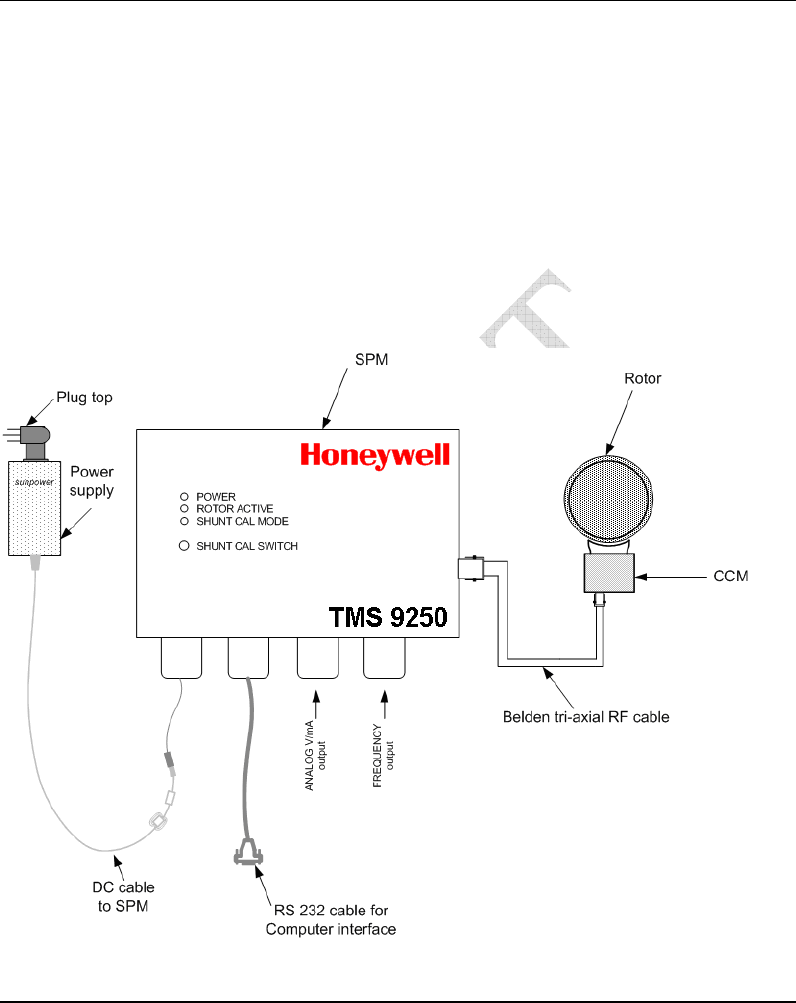
1. TMS 9250 Torque Measurement System
1.3. In The Box
Rev: A
008-0738-00
V 1.0 TMS 9250 Product User Manual 13
May 2011 Honeywell Confidential & Proprietary
1.3 In The Box
• Plug top
• Power supply
• SPM
• Rotor
• CCM
• RF cable
• RS-232 cable
• Alignment Tool

1. TMS 9250 Torque Measurement System
1.4. Intended Use
Rev: A
008-0738-00
14 TMS 9250 Product User Manual V 1.0
Honeywell Confidential & Proprietary May 2011
1.4 Intended Use
Torque Sensor
Lebow Torque Sensors are designed structures that perform in a predictable and
repeatable manner when a torque is applied. This torque is translated into a signal voltage
by the resistance change of strain gages, which are attached to the torque sensor
structure. The change in resistance indicates the degree of deformation, and in turn, the
torque on the structure.
The strain gages are connected in a 4 arm Wheatstone Bridge configuration which acts as
an adding and subtracting electrical network and allows compensation for temperature
effects as well as cancellation of signals caused by extraneous loading.
When the torque sensor is rotating, a means must be provided to transfer an excitation
voltage to the rotational element from a stationary surface, and also to transfer the torque
signal from the rotational element back to the stationary surface. This is accomplished
through the use of digital telemetry.
Principle of Telemetry
The digital telemetry system consists of a receiver-transmitter module, a caliper-style
coupling module, and a signal processing module.
The receiver-transmitter module is an integral part of the torque sensor and is connected
to the strain gauges and to the epoxy glass annular printed circuit board that contains the
rotating antenna system. Within the receiver-transmitter module, the sensor signals are
amplified, digitized, and are then used to modulate the radio frequency carrier wave that
is detected by the antenna after being transmitted across the air gap by the caliper
coupling module. That same carrier wave is rectified to provide power to drive the strain
gauges and the electronic components in the module, which is managed by a miniature
microprocessor.
The caliper coupling module connects to the signal processing module via a Tri-axial
cable. The detector circuitry in the signal processing module recovers the digital
measurement data from the torque sensor and passes it to the second microprocessor for
scaling and linearizing.
The third microprocessor provides the drive to the two analog outputs, as well as the
standard digital interfaces and the optional digital interface modules. Extensive facilities
are provided in software for setup and configuration of the complete system.

1. TMS 9250 Torque Measurement System
1.5. Installation and Setup
Rev: A
008-0738-00
V 1.0 TMS 9250 Product User Manual 15
May 2011 Honeywell Confidential & Proprietary
Usage scenario of TMS 9250
This product is used in the controlled environment, not for the intended out door use, and
designed typically for dynamometer test laboratories.
Refer to the cleaning instructions provided in the Appendix D.
1.5 Installation and Setup
To create DSN using EBIDataSource:
Step Action
Bolting
Information
Tighten all bolts, in incremental steps, to the bolt manufacturers rated
torque specification. Use the respective sequence illustration shown
below depending on the number of bolts the sensor requires. This
bolting sequence applies to both bolt circles of the torque sensor.
Torque
Sensor
The TMS 9250 series torque sensors may be operated horizontally,
vertically, or any angle in between provided the load is applied through
the loading axis.
All torque sensors in this series have bolt patterns that mate directly to
standard industrial couplings. When mounted, one of the flanges
should be mated to a good quality double flex coupling or a driveshaft
arrangement that incorporates universal joints at each end. This is
designed to compensate for angular and parallel misalignment.
Avoid applications that place extraneous loads on the torque sensor.

1. TMS 9250 Torque Measurement System
1.5. Installation and Setup
Rev: A
008-0738-00
16 TMS 9250 Product User Manual V 1.0
Honeywell Confidential & Proprietary May 2011
Step Action
Caliper
Coupling
Module
The caliper coupling module must be firmly mounted to a non-rotating
support structure. It must be aligned with the epoxy glass annular
printed circuit board antenna so that the air gap between the caliper
and the antenna is approximately equal on both sides. Care should be
taken to avoid any items touching one another, and consideration
should be given to the effects of vibration as well as the free play in
any driveshaft sliding joints.
To assist in the process of aligning the caliper and the antenna, a
simple plastic alignment tool is provided with each system. The tool is
used to hold the required clearance between the caliper and the
antenna while the caliper fixing bolts are being tightened, and then is
removed before the sensor is rotated.
The tolerances for end-float (axial) are +/-
4.5mm (+/- 3/16”) and for run-out (radial) are +/-
1.0mm (+/- 1/16”). For installations where run- out cannot be
controlled within the specified tolerance, the secondary coupling
position can be used. This is achieved by placing the edge of the
caliper in close proximity to the edge of the antenna. In this position,
the run-out tolerance can be at least doubled, at the expense of a
reduced signal to noise ratio caused by the higher incidence of data
drop outs. The axial tolerance is limited by the distance between the
caliper sections.
The caliper can also be mounted such that only one side is in
proximity to the antenna, if the mounting arrangement does not allow
for placing of the antenna between the two sides of the caliper.
Successful positioning of the caliper can be confirmed by the
quality test of the TMS tool kit returning 100% result.
The length of the RF cable connection between the caliper coupling
module and the signal processing module is critical to system
performance (due to reflections and standing waves). You mustuse
tri-axial cable only of length 14.6 meters (47’11’’ feet) supplied with
the product.
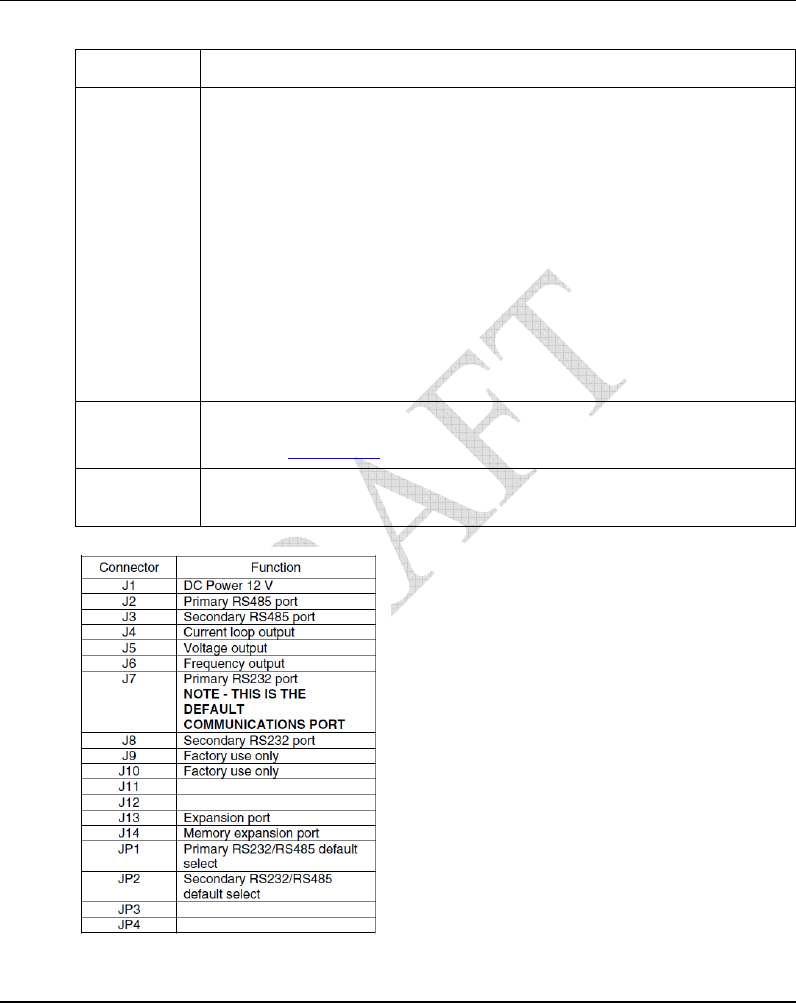
1. TMS 9250 Torque Measurement System
1.5. Installation and Setup
Rev: A
008-0738-00
V 1.0 TMS 9250 Product User Manual 17
May 2011 Honeywell Confidential & Proprietary
Step Action
Signal
Processing
Module
The receiver is mounted remotely with the tri-axial cable being the only
connection between it and the caliper coupling module. The receiver
has holes provided for permanent mounting. Request appropriate
certified drawing from Lebow before making fixtures.
When deciding where to locate the signal processing module,
consideration should be given to the type of output that will be
used. If the analog voltage or current output is to be used, then the
signal processing module should be mounted in an area of low
electrical noise and the connection between the module and the data
acquisition equipment should be as short as possible made up of
double screened twisted pair cable. If the frequency output or the
digital output is to be used, then the signal processing module can be
mounted in the electrically noisy area provided that good quality dual
screened twisted pair cables are used.
Electrical
connection
As mentioned in table below.
Refer to Appendix E for SPM IO box connections
Powering of
device
After all the connection are completed then system shall be power and
allowed for 30-45min warm-up time for stable output
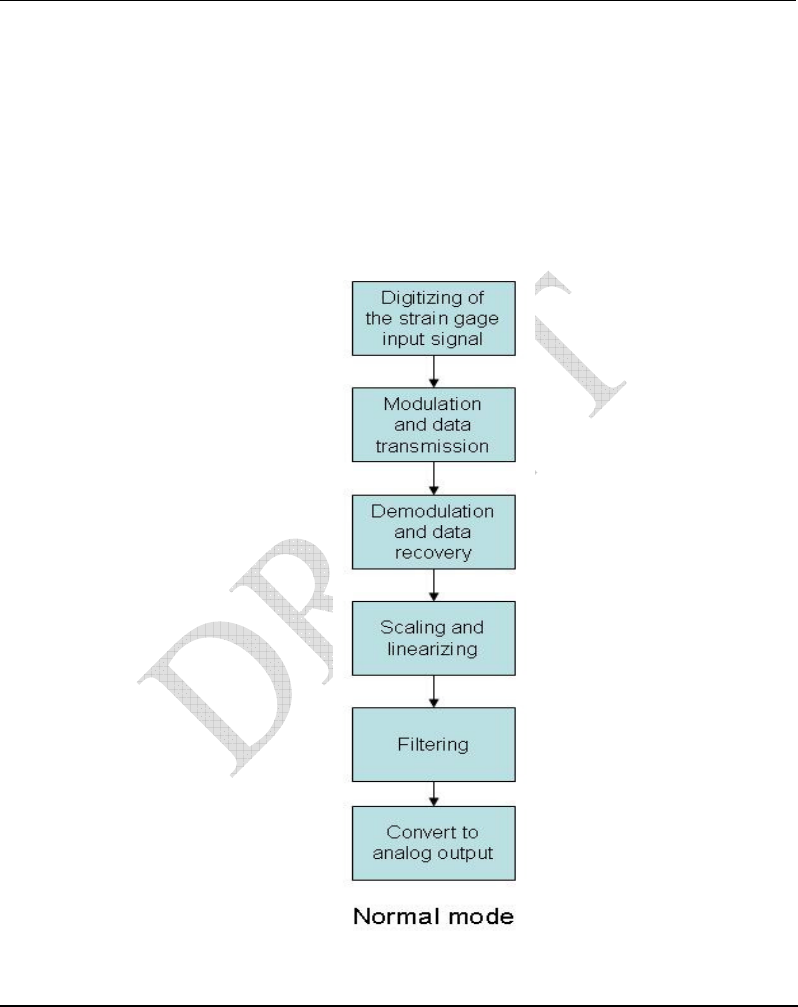
2. Modes of Operation
2.1. Normal mode operation detailed description
Rev: A
008-0738-00
18 TMS 9250 Product User Manual V 1.0
Honeywell Confidential & Proprietary May 2011
2. Modes of Operation
2.1 Normal mode operation detailed description
Normal mode operation
The flow of data in the TMS 9250 is subjected to various forms of processing as it passes
from input to output.
This process is best described by use of a flow chart as follows:

2. Modes of Operation
2.1. Normal mode operation detailed description
Rev: A
008-0738-00
V 1.0 TMS 9250 Product User Manual 19
May 2011 Honeywell Confidential & Proprietary
The data is transmitted from the rotor at the maximum data rate but the rate has to be
slowed down for linearizing and scaling due to
the amount of processing required – the TMS 9250 features independent scaling of the
input and output, using floating point values for convenience of the user, and the
linearizing routine can use up to 9 data points (user selectable), so a significant amount of
processor power is consumed during these floating point calculations.
The next process is digital filtering, using a parameter driven recursive algorithm that
performs output smoothing but also provides a separate parameter that controls a filter
bypass in the event of a significant change in input being required to be reflected through
to the output without delay.
The filtered data is then converted to the required analog output format or formats (the
TMS 9250 can drive the voltage or current loop output at the same time as providing a
frequency output) using the output scaling parameters that are independent from the input
calibration.
The rate at which the microprocessor can perform the separate linearizing and scaling
calculations is the limiting factor in determining the available bandwidth of the TMS
9250.
To provide a faster response for users that want to analyze the dynamic data, a
FASTMODE is provided, and in this mode, the data is “piped” directly from the rotor to
the analog voltage output.
The benefit of this mode is that the analog voltage output is updated at the maximum data
rate, which is eight times faster than the normal mode rate.
The penalty of using fastmode is that the scaling and linearizing stages are bypassed, so
the relationship between input and output becomes fixed, and the only way to calibrate
the output against the input is to calculate the expected change in output value (by
reference to the calibration data stored in the TMS 9250), or perform a physical system
calibration or to use the SHUNT CAL feature.
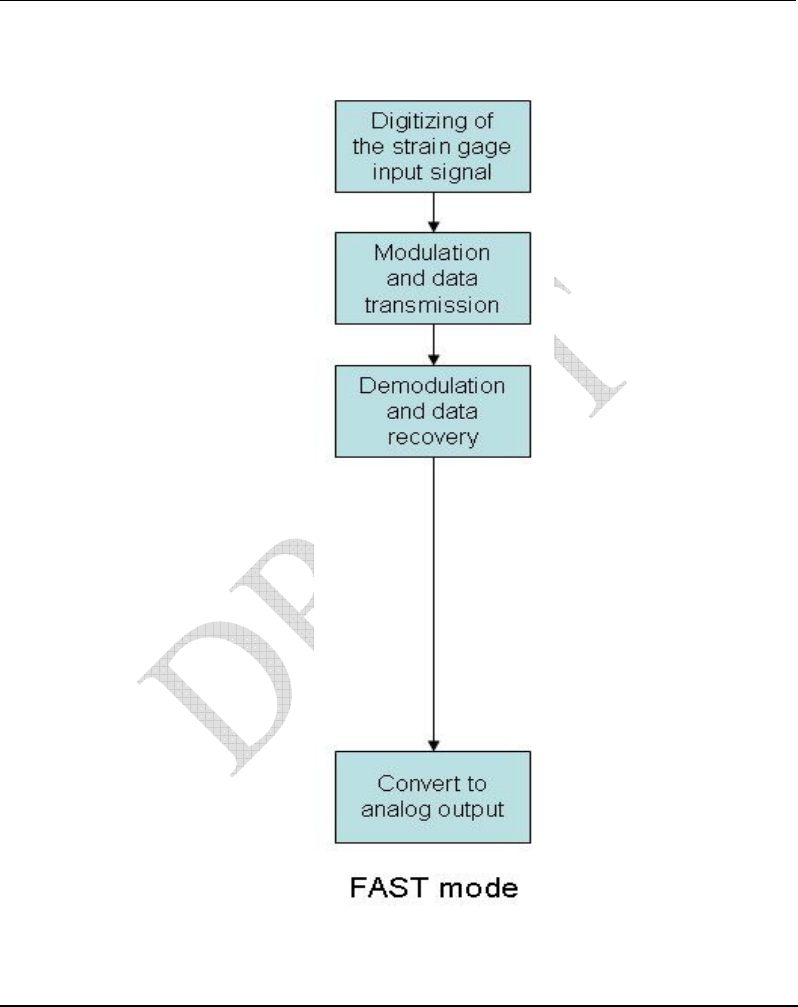
2. Modes of Operation
2.1. Normal mode operation detailed description
Rev: A
008-0738-00
20 TMS 9250 Product User Manual V 1.0
Honeywell Confidential & Proprietary May 2011
The following diagram shows the change in data flow when using FASTMODE.

2. Modes of Operation
2.2. Fast mode operation detailed description
Rev: A
008-0738-00
V 1.0 TMS 9250 Product User Manual 21
May 2011 Honeywell Confidential & Proprietary
Because of the significant change in output characteristics that takes place when
FASTMODE is selected, it is implemented as a VOLATILE setting, therefore recycling
the power or performing a soft reset will return the TMS 9250 to NORMAL mode.
As an indication to the user that FASTMODE is in operation, the ROTOR ACTIVE light
on the lid of the TMS 9250 Signal processing Modules (SPM) is de-activated.
2.2 Fast mode operation detailed description
Fast hmode operation
The strain gage input value is digitized at a rate of 17,656 samples per second with 24-
bit resolution, but this amount of data is in excess of the capacity of the telemetry link,
so it is reduced by the simple averaging of every pair of A-D results at the rotor
electronics module. The data that is transmitted across the telemetry gap consists of 8,828
results per second at a resolution of 16-bit, and it is this data that is then piped directly to
the analog voltage output whenever FASTMODE is turned on.
The analog voltage output channel is a 16-bit digital-to-analog converter with a
bandwidth of greater than 3 kHz, therefore the expected analog output voltage for a full
scale torque measurement can be calculated by reference to the calibration data tables
held in the TMS 9250.
Assuming that the factory calibrated (or user re- calibrated) data tables can be accessed
using the CAL user mode of the TMS Toolkit, the
Output calibration can be determined using this theoretical method, an example of which
will be given later.
When the TMS Toolkit is not available, the user will need to perform a physical system
calibration by placing a known torque on the sensor and measuring the change in the
analog output voltage.
In cases where the shunt calibration value is known, the change in output due to shunt
calibration can be measured and the result extrapolated to give a full scale equivalent.
Note that this result will need to be adjusted when the shunt cal scaling feature has been
used (#SCSCALE is something other than 1). An example of calculating the analog
output voltage by using shunt cal and the #SCSCALE parameter is also given later.

2. Modes of Operation
2.2. Fast mode operation detailed description
Rev: A
008-0738-00
22 TMS 9250 Product User Manual V 1.0
Honeywell Confidential & Proprietary May 2011
Normal mode and FASTMODE data update rates
Mode Data rate
NORMAL When FILTSTEPS>1, data rate is 1104 results per second
NORMAL When FILTSTEPS=1, data rate is 2207 results per second
FASTMODE 8828 results per second
Note
Note that the analog voltage output channel should be only channel
is use for any data rate above 1104 results per second. Therefore
OPTYPE should be set to 1.
Note that any traffic on the RS-232 port caused by TMS Toolkit or
any other communications package will disrupt the flow of data due
to the interrupts that are generated by the external software.
Examples
The following examples assume that either the TMS Toolkit is available and running in
CAL user mode, or that a hard copy of the parameters list is available and valid.
Example 1 – Theoretical determination of analog output value
The relationship between torque and digital counts can be determined by reference to
the parameters held in the TMS 9250. When in FASTMODE, the digital counts received
from the rotor are simply piped through to the analog voltage output channel, so the
counts values can be used to determine the expected analog output values (actual
values may vary within the calibration accuracy of the analog output channel, usually
within 0.1%FS).
Consider a sensor with a 2000Nm full scale torque measuring range
Calibration values most likely to have been used will be (approximately) -2000, 0 and
+2000 Nm
The actual values used may have been adjusted to take account of local gravity and
buoyancy and can be seen from the parameters #CALVALUE1, 2 and 3
Make a note of the actual values used and compare them to the values of #CALCNTS1, 2
and 3
The #CALCNTSx values store the digital counts values that were output by the rotor for
the load conditions given by the relevant #CALVALUEx
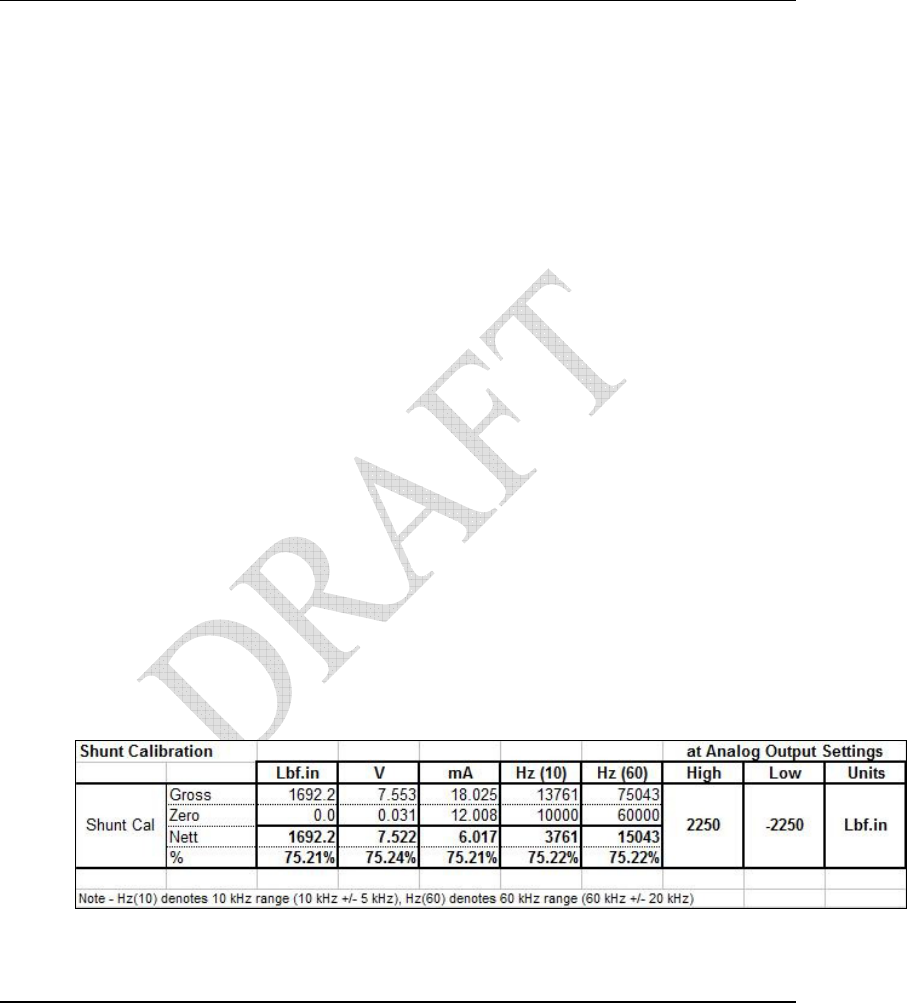
2. Modes of Operation
2.2. Fast mode operation detailed description
Rev: A
008-0738-00
V 1.0 TMS 9250 Product User Manual 23
May 2011 Honeywell Confidential & Proprietary
The analog voltage output channel is 16-bit and it will generate an output of -10V when
it is driven by a counts value of 0, and will generate an output of +10V when driven by a
COUNTS value of 65535. Therefore each count generates 0.0003052V starting from a
base of -10V.
The analog voltage output will be generated in direct relationship to the statement above.
Therefore, using the following data, the analog voltage output will be:
#CALVALUE1=-1998.699 #CALCNTS1=21553
Therefore at a load of -1998.699 Nm, the analog Voltage will be (21553*0.0003052)-
10V = -3.422V
#CALVALUE2=0.000000 #CALCNTS2=32700
Therefore at a load of 0 Nm, the analog Voltage will be (32700*0.0003052)-10V = -
0.020V
#CALVALUE3=1998.500 #CALCNTS3=43842
Therefore at a load of +1998.500 Nm, the analog Voltage will be (43842*0.0003052)-
10V = +3.381V
Example 2 - Using the SHUNT CALIBRATION feature
The shunt cal feature operates by switching-in a high precision shunt resistor across
one of the arms of the strain gage bride on the rotor. The change in output that occurs
due to this shunting is repeatable and is often used as a means of calibration. During
factory calibration, the apparent change in torque output due to shunt cal will have been
recorded, and this value can be used to re-calibrate the analog voltage output when in
FASTMODE.
Consider a sensor with a 2250 Lbf.in measuring range. The factory calibration certificate
will include the changes due to shunt cal as a list of effects such as follows :
When in FASTMODE, the shunt cal values for voltage, current and frequency are invalid
because the scaling module is bypassed, so the only piece of information that remains

2. Modes of Operation
2.3. Analog Output characteristics
Rev: A
008-0738-00
24 TMS 9250 Product User Manual V 1.0
Honeywell Confidential & Proprietary May 2011
valid and that we need to use from this data table is the apparent change in TORQUE due
to shunt cal, and in the case of this example, it is 1692.2 Lbf.in
It follows that the change in analog voltage output when in FASTMODE will represent
1692.2 Lbf.in
The exception to this case will be when a value has been set for #SCSCALE. This
parameter allows the effect of shunt cal to be varied, according to the value set. The
default is 1 and any other value acts as a multiplier – but only when the scaling module is
operating.
For FASTMODE operation, the scaling module is bypassed so the effect of shunt cal will
be the original effect, as manufactured, and may be significantly different from the
calibration certificate value.
To compensate for any value of #SCSCALE, calculate as follows : Certificated change in
torque due to shunt cal is 1692.2 Lbf.in Value set for #SCSCALE is 1.5
Actual change due to shunt cal is 1692.2/1.5 = 1128.13 Lbf.in
If #SCSCALE is 1, then no calculation is necessary.
2.3 Analog Output characteristics
The analog output channel is specified for a bandwidth of 3 kHz so there is no output
filtering that follows the digital-to-analog converter (DAC). This can lead to a
“staircasing” effect when the DAC is being updated at a relatively slow rate such as
1104Hz.
For users that do not require wide bandwidth, this staircasing will not be a problem and
can be eliminated from the measurement by applying a suitable sampling rate at the
data acquisition end. Typically, a sampling rate of one quarter of the TMS 9250 DAC
update rate (or less) would be sufficient to solve this problem.
For applications where the fidelity of the output waveform is of prime importance, the
solution to staircasing is to add a filter network across the analog voltage output
terminals.
When using FASTMODE, the DAC is being updated at a rate of 8828 Hz therefore
staircasing is reduced as a result of the much faster update rate.

3. Calibration
3.1. System Calibration Method
Rev: A
008-0738-00
V 1.0 TMS 9250 Product User Manual 25
May 2011 Honeywell Confidential & Proprietary
3. Calibration
3.1 System Calibration Method
The TMS 9250 features nine-point linearization and all calibration are achieved using the
following parameters:
#CalSteps
#CalReset
#CalValue1
#CalValue2
#CalValue3
#CalValue4
#CalValue5
#CalValue6
#CalValue7
#CalValue8
#CalValue9
The minimum number of calibration points is 2. Calibration points can be created in any
order provided that the values they contain are in ascending order starting with
#CalValue1. Therefore, the lowest or the most negative (counter-clockwise) calibration
point should be designated as #CalValue1.
The number of calibration points that are in use is set by the parameter “#CalPoints”.
Any change to the value of #CalPoints should be followed by the issuance of a
“#CalReset” command, to clear the old calibration values from the EEPROM memories.
Calibration is achieved by applying known loads at each of the calibration points that are
selected for use and then writing the engineering units value to the appropriate
#CalValuex parameter.
The analog outs are precalibrated in the factory, so calibration of the input to the required
output range is automatic and is dependent on the values entered for the parameters
#AnOutHigh
#AnOutLow
#AnOutHigh and #AnOutLow are written-to using the engineering units value at which
the analog outputs are required to give the maximum and minimum outputs.

3. Calibration
3.2. Shunt Calibration
Rev: A
008-0738-00
26 TMS 9250 Product User Manual V 1.0
Honeywell Confidential & Proprietary May 2011
Available analog outputs are: Voltage range is –10 to +10 volts.
Current output range is 4 to 20 mA. Frequency range is 5 kHz to 15 kHz or alternatively,
40 kHz to 80 kHz
Calibration Example:
To calibrate from –100 to +100 Nm in five steps of –100, -50, 0, +50 and +100 Nm:
Set #CalSteps=5
#CalReset
Apply –100 Nm and set #CalValue1=-100,
Apply –50 Nm and set #CalValue2=-50
Apply 0 Nm and set #CalValue3=0
Apply +50 Nm and set #CalValue4=50
Apply 100 Nm and set #CalValue5=100
To obtain a frequency output of 5 kHz at 10 Nm and 15 kHz at 80 Nm then the
parameters would be #AnOutLow=10 and #AnOutHigh=80.
The device will then be fully calibrated. Note that for best results and to conform to
accepted calibration practice, the unit under test should be exercised three times at the
full load in the direction of loading prior to the setting of calibration points. This is
especially important when calibrating in both the clockwise and the counterclockwise
directions. Please contact the factory for a detailed description of calibration practice and
procedure.
If an alternative analog output is selected at a later date, or if different settings are chosen
for the #AnOutHigh/Low parameters later, it is not necessary to repeat the loading
calibration because all analog outputs are digitally driven.
3.2 Shunt Calibration
An electrical signal equivalent to that produced by a known load can be obtained by
activating the shunt calibration function. The shunt calibration function is built in to the
sensor itself, and it is therefore necessary for the Rotor Active light to be showing before
the function can be operated. By design, the caliper coupling module is more sensitive to
receiving data than it is to transmitting data, therefore it may be necessary to adjust the
caliper coupling module position to ensure good two-way communications, prior to
using the shunt cal function.
The shunt calibration function is achieved by connecting a high-precision resistor of
know value, in parallel (shunt) with one arm of the strain gage Wheatstone bridge. The
connection is made by a solid state switch, under the control of the microprocessor on the
rotating sensor, when commanded by the remote Signal Processing Module. This switch

3. Calibration
3.3. Storage and Recalibration
Rev: A
008-0738-00
V 1.0 TMS 9250 Product User Manual 27
May 2011 Honeywell Confidential & Proprietary
can be activated via the pushbutton on the face of the signal processing module. The
shunt calibration value is determined during factory calibration of the torque sensor.
The shunt calibration function is a very useful aid when setting up the system or when
fault finding. This function can be used as an alternative in applications where it is neither
possible nor practical to perform dead weight system calibration. However, there can be
some loss of calibration accuracy. To provide for this eventuality, the shunt calibration
value is factory-set to represent between 50% and 95% of full scale. This is achieved using
high grade resistors that exhibit very low thermal sensitivity.
3.3 Storage and Recalibration
This torque measurement system may be stored for an indefinite period in a dry place at
room temperature. Recalibration should follow normal instrumentation certification
schedule.

4. Troubleshooting
4.1. “Power On” light is not showing
Rev: A
008-0738-00
28 TMS 9250 Product User Manual V 1.0
Honeywell Confidential & Proprietary May 2011
4. Troubleshooting
The following is the sequence in which a typical installation should proceed:
4.1 “Power On” light is not showing
• Check that 12VDC is being applied to the correct terminals (J1) and at the correct polarity.
• In certain cases, for example where the caliper coupling module has been left in direct contact
with a metal surface for some time, the internal thermal protection circuit may have activated.
•
To reset this condition, remove power and wait ten minutes before restoring power.
4.2 “Rotor Active” light is not showing
• Check that the RF cable is in good condition and is of the correct length (look for damage to
the outer sheath that may indicate that the cable has been crushed at some time).
• Check that the caliper coupling module has been correctly positioned in close proximity to the
rotating antenna. Use the positioning guide that was supplied with the system to confirm the
position. Move the caliper coupling module to try and achieve coupling in an alternative
position.
• Check that there are no metal parts (flanges, covers, etc), within one and a half inches
(40mm) of the caliper coupling surfaces.
• Check that the power supply is actually 12 VDC when the caliper coupling module is in the
appropriate position (some power supplies have built-in protection circuits that cause a
reduction in supply voltage when current demands increase.
4.3 Shunt calibra-tion does not operate
• Check that the “Rotor Active” light is showing, prior to using the shunt calibration function.
• Check that the RF cable is in good condition and is of the correct length (look for damage to
the outer sheath that may indicate that the cable has been crushed at some time).
• Check that the caliper coupling module has been correctly positioned in close proximity to the
rotating antenna. Use the positioning guide that was supplied with the system to confirm the

4. Troubleshooting
4.4. Cannot communicate.
Rev: A
008-0738-00
V 1.0 TMS 9250 Product User Manual 29
May 2011 Honeywell Confidential & Proprietary
position. Move the caliper coupling module to try and achieve coupling and shunt cal
functionality in an alternative position.
• Check that there are no metal parts (flanges, covers, etc), within one and a half inches (40mm)
of the caliper coupling surfaces.
• Check that the power supply is actually 12 VDC when the caliper coupling module is in the
appropriate position (some power supplies have built-in protection circuits that cause a
reduction in supply voltage when current demand increase).
Make sure “scon” shunt cal on command is not given in software tool kit. Which will
make shunt cal on always. Type in scoff in the tool kit to switch off shunt cal. Refer to
the TMS Tool kit User Manual for more information.
4.4 Cannot communicate.
• Check all wiring.
• If using the RS232 port, check that the Rx pin of the host computer is connected to the Tx pin
of the TMS 9250 and vice versa.
• Check that the communications cable being used is of high quality or try a shorter length of
cable (RS232 is sensitive to cable length and grounding issues, especially when used with
laptop computers where grounding is uncertain).
• Check that the correct serial port is selected in the software or TMS Toolkit. When using
Windows, the serial port in use can be found by using the CONTROL PANEL, SYSTEM,
HARDWARE, DEVICE MANAGER, COM ports functions.
• On older desktop PC’s, the COM1 port is already in use for the mouse, so a different COM
port should be selected.
• If using a USB to Serial adapter, Windows assigns the COM port designations dynamically so
they may change whenever the system is rebooted.
• The serial port settings are automatically modified by TMS Toolkit so there is no need to
change any of the settings in Windows.
• The baud rate setting in TMS Toolkit should always be 38400 because that is the default baud
rate of the TMS 9250.
• The “TMS ID” should be left blank because TMS Toolkit will search the connected port for
any TMS device and will commence the communication automatically if present.
• Refer to the TMS Toolkit User Manual for more information

5. Product Specifications
4.4. Cannot communicate.
Rev: A
008-0738-00
V 1.0 TMS 9250 Product User Manual 31
May 2011 Honeywell Confidential & Proprietary
5. Product Specifications
Product Feature Product Specification
Power supply
•
90~264V AC 47~63 Hz
Protection
•
Short Circuit and over voltage protection
Pollution degree
•
3
Analog output signals
•
4-20 mA (zero torque = 12 mA)
•
+/- 10 VDC (zero torque = 0 V)
•
10 kHz +/- 5 kHz (zero torque = 10 kHz)
•
60 kHz +/- 20 kHz (zero torque = 60 kHz)
Output drives capability
•
4-20 mA 400 Ohms max including cable
resistance
•
+/- 10 VDC 2 k Ohms min
•
Frequency 4 V p-p for 100 k Ohms 2.3 V
p-p for min load of 1k Ohms
Digital resolution
•
Normal mode 16-bit ( 0.01 %FS)
•
Hi-res mode 19-bit (0.001 %FS) RF
carrier frequency 13.56 MHz
Accuracy
•
System 0.050% FS typical*
•
*4-20mA Current output drifts with input
power supply change around the nominal
12V
Temperature Range
•
Operating, Sensor and CCM Only
•
40 to 85 C (-40 to 185 F)
•
Operating, SPM and Power Supply
•
0 to 40 C (32 to 104 F)
•
Compensated
•
10 to +50 C (14 to 122 F)
•
008-0738-00
Frequency response
•
Input sampling rate 17,656 samples/sec
•
Anti-aliasing

5. Product Specifications
4.4. Cannot communicate.
Rev: A
008-0738-00
32 TMS 9250 Product User Manual V 1.0
Honeywell Confidential & Proprietary May 2011
•
filter fixed) 4.1kHz
•
Telemetry update rate 8.828 kHz
•
Fast mode data
•
throughput rate 8.828 kHz
•
Normal mode data
•
throughput rate 1.104 kHz
•
Analog output
•
bandwidth (max) 3 kHz @ -3 db
•
Group delay (typical,
•
normal mode) 2.5ms
•
Group delay (typical,
•
fast mode) 1.2ms
Digital filtering
•
FIR mode 0.1 through 1000 Hz
•
IIR mode recursive algorithm

6. Appendices
6.1. APPENDIX A
Rev: A
008-0738-00
V 1.0 TMS 9250 Product User Manual 33
May 2011 Honeywell Confidential & Proprietary
6. Appendices
The following section describes about different appendices related to the TMS 9250
Torque Measurement System.
The following section describes about different appendices related to the TMS 9250
Torque
Measurement System.
Appendix A – Supplement for TMS 9250 SPM Remote Shunt Cal Option.
Appendix B – Supplement for TMS 9250 SPM Digital Filter Settings.
Appendix C – Supplement for Conversion table.
Appendix D – Supplement for power supply positioning, product grounding and cleaning
instructions.
Appendix E - Setting up the Cables for the Signal Processing Module (SPM).
6.1 APPENDIX A
Manual Supplement for TMS 9250 SPM Remote Shunt Cal Option
This supplement provides information on the operation and specifications of the TMS
9250 SPM with the Remote Shunt Cal Option, P/N 064-LW37039.
Overview
The TMS 9250 SPM with Remote Shunt Cal option allows the user to remotely activate
and deactivate the shunt cal mode via an external switch and cable.
Setup
The Remote Shunt Cal option is installed and tested at the factory. A six-pin circular
connector is mounted to the front panel of the SPM box as a connection point for the
remote shunt cal switch. A mating connector (023-LW181-034) is provided so the user
can attach a cable between the SPM and the customer supplied switch.
Step Action
a Connect a two-conductor cable between the remote switch and the
mating connector. Solder one conductor to pin A of the mating
connector and the other conductor to pin B. Attach the strain relief
to the connector.

6. Appendices
6.2. APPENDIX B
Rev: A
008-0738-00
34 TMS 9250 Product User Manual V 1.0
Honeywell Confidential & Proprietary May 2011
Step Action
b Attach the mating connector to the six pin connector on the SPM
c After setting up the sensor and caliper module, power on the SPM
and verify the Power LED and the Rotor Active LED is lit on the top
of the SPM. Turn on the remote shunt cal switch and verify the
Shunt Cal Mode LED is lit on the top of the SPM. Turn off the remote
shunt cal switch and verify the Shunt Cal Mode LED turns off.
d Setup of the Remote Shunt Cal Option is complete.
6.2 APPENDIX B
Manual Supplement for TMS 9250 SPM Digital Filter Settings
This supplement provides information on the operation and specifications of the TMS
9250 SPM with the Digital Filter Settings, as they relate to v1.38 software.
Intended Use
This supplement is intended for the purpose of describing the function and operation of
the digital filtering algorithms that are included in the TMS 9250 version 1.38 firmware.
It should be used in conjunction with the TMS 9250 User Manual and the TMS Toolkit
User Manual, both of which are supplied with a TMS 9250 Torque Measuring System.
Filter Operation General Description
The digital filter algorithm in the v1.30 and later firmware versions of the TMS 9250 is
basically a recursive filter that behaves like an “RC” circuit.
It has two user settings, the first being a “level” set by the parameter FiltLevel, and the
second being a filter “weight”, set by the parameter FiltSteps.
The “level” works as a threshold, above which the filter is reset to allow a fast response
to a event that exceeded the threshold. This is useful in the case when well-damped
steady state data is required, but when significant fast transients and disturbances should
not be filtered out.
The “weight” of the filter is set by increasing the number of filter steps, which in turn
increases the time constant of the RC filter, increasing the damping effect.
The settings of any of the TMS 9250 parameters can be changed at any time via the
RS232 communications link. Changing parameters while the system is running will take
effect immediately, and in the case of filter setting changes, will become effective as
soon as the filter flushes through.

6. Appendices
6.2. APPENDIX B
Rev: A
008-0738-00
V 1.0 TMS 9250 Product User Manual 35
May 2011 Honeywell Confidential & Proprietary
The TMS Toolkit software, supplied with the TMS 9250 system, simplifies the task of
changing settings, although any character-based communications software could be used
instead (e.g. HyperTerminal).
Filter Operation Detailed Description
Consider the input signal as being V
i
and the output signal being V
o
In a steady state situation, V
o
will equal V
i
When V
i
changes, the extent of the change is compared with the threshold, which is set
as a proportion of the full scale sensitivity, by the parameter FiltLevel.
If the change exceeds the threshold, then the new input value is passed immediately to the
output, thereby resetting the filter.
If the change does not exceed the threshold, then the output value V
o
is updated by a
fractional amount of the new value V
i
until the output value equals the input value
again. The number of steps set by FiltSteps determines the number of fractional steps
that are taken to increment the output value, according to the following series :
1 / 2, 1 / 3, 1 / 4, 1 / 5 ….etc
The output characteristic is therefore exponential and behaves in a predictable manne.
To determine the settling time of the filter (the time taken to reach the V
o
= V
i
condition), it is necessary to know both the filter update rate and the number of
fractional steps. The filter update rate is fixed at 1000 Hz in the firmware v1.30 and
above, although other filter update rates can be made available upon request to the
factory.
The cut-off point (in Hz) is given by the expression
Frequency (-3dB)=
(Update rate/number of steps)/6.3
The table below provides a quick reference to determine the filter characteristic
Note that this filter operates only when the cha Consider the input signal as being
V
i
and the output signal being V
o
In a steady state situation, V
o
will equal V
i
When V
i
changes, the extent of the change is compared with the threshold, which is set
as a proportion of the full scale sensitivity, by the parameter FiltLevel.
If the change exceeds the threshold, then the new input value is passed immediately to the
output, thereby resetting the filter.
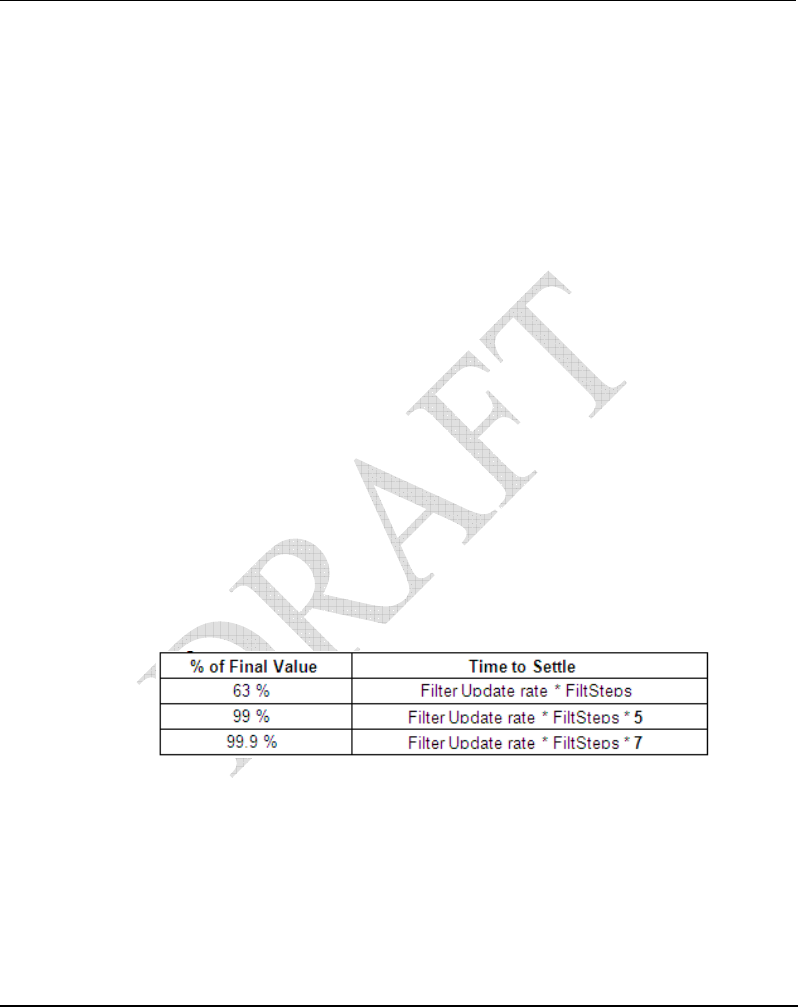
6. Appendices
6.2. APPENDIX B
Rev: A
008-0738-00
36 TMS 9250 Product User Manual V 1.0
Honeywell Confidential & Proprietary May 2011
If the change does not exceed the threshold, then the output value V
o
is updated by a
fractional amount of the new value V
i
until the output value equals the input value
again. The number of steps set by FiltSteps determines the number of fractional steps
that are taken to increment the output value, according to the following series :
1 / 2, 1 / 3, 1 / 4, 1 / 5 ….etc
The output characteristic is therefore exponential and behaves in a predictable manne.
To determine the settling time of the filter (the time taken to reach the V
o
= V
i
condition), it is necessary to know both the filter update rate and the number of
fractional steps. The filter update rate is fixed at 1000 Hz in the firmware v1.30 and
above, although other filter update rates can be made available upon request to the
factory.
The cut-off point (in Hz) is given by the expression
Frequency (-3dB)=(update rate/number of steps)/6.3
The table below provides a quick reference to determine the filter characteristic
Note that this filter operates only when the change in the input is below the threshold set
by FiltLevel.
The time required for the output to settle following a step change in input level is
given by the following table.
Filter Settling Time
The time required for the output to settle following a step change in input level is
given by the following table.
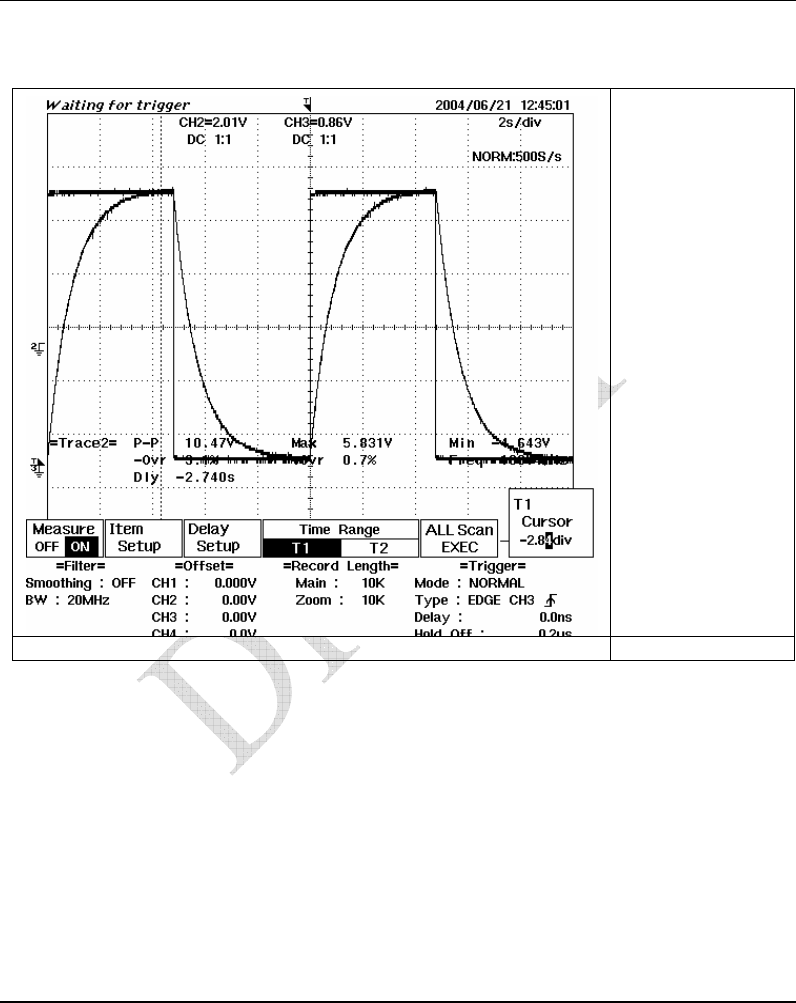
6. Appendices
6.2. APPENDIX B
Rev: A
008-0738-00
V 1.0 TMS 9250 Product User Manual 37
May 2011 Honeywell Confidential & Proprietary
Sample Charts
INPUT : Square
Wave, 0.1 Hz
OUPUT : Analog
Voltage
FiltLevel=10000
FiltSteps=1000
Settling time to 99%
is given by
5 * 0.001 * 1000 = 5
seconds
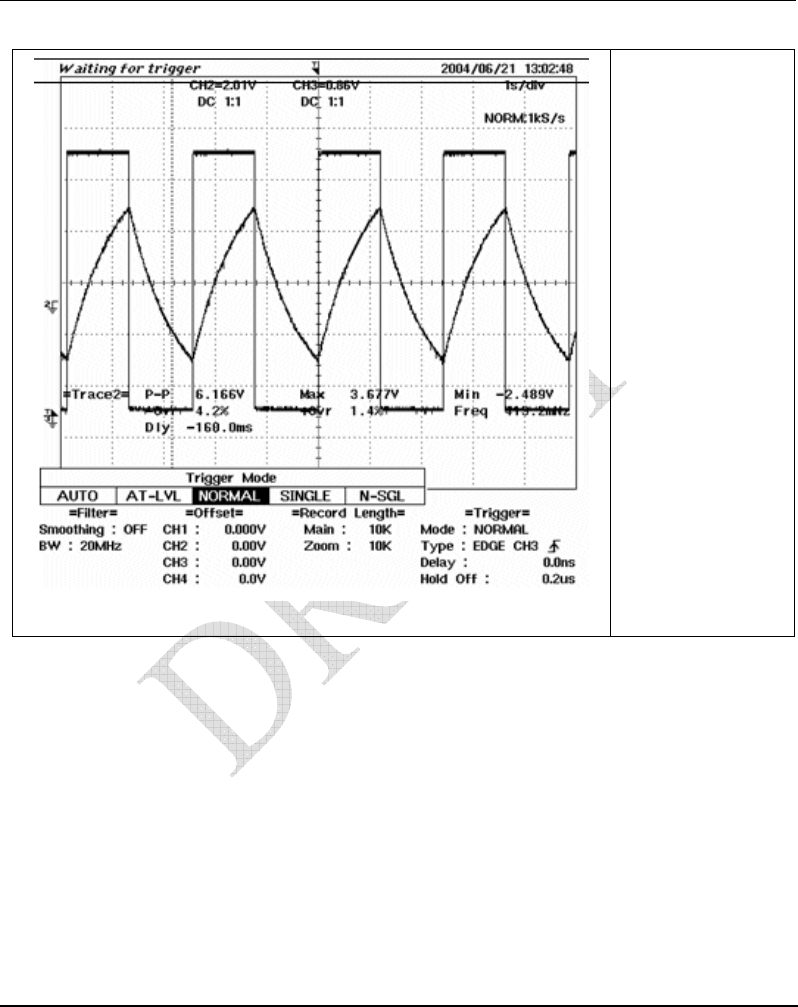
6. Appendices
6.2. APPENDIX B
Rev: A
008-0738-00
38 TMS 9250 Product User Manual V 1.0
Honeywell Confidential & Proprietary May 2011
INPUT : Square
Wave, 0.4 Hz
OUPUT : Analog
Voltage
FiltLevel=10000
FiltSteps=1000
Settling time to 99%
is given by
5 * 0.001 * 1000 = 5
seconds
Therefore
overdamped
response, only
reaching 60% of full
scale p-p value
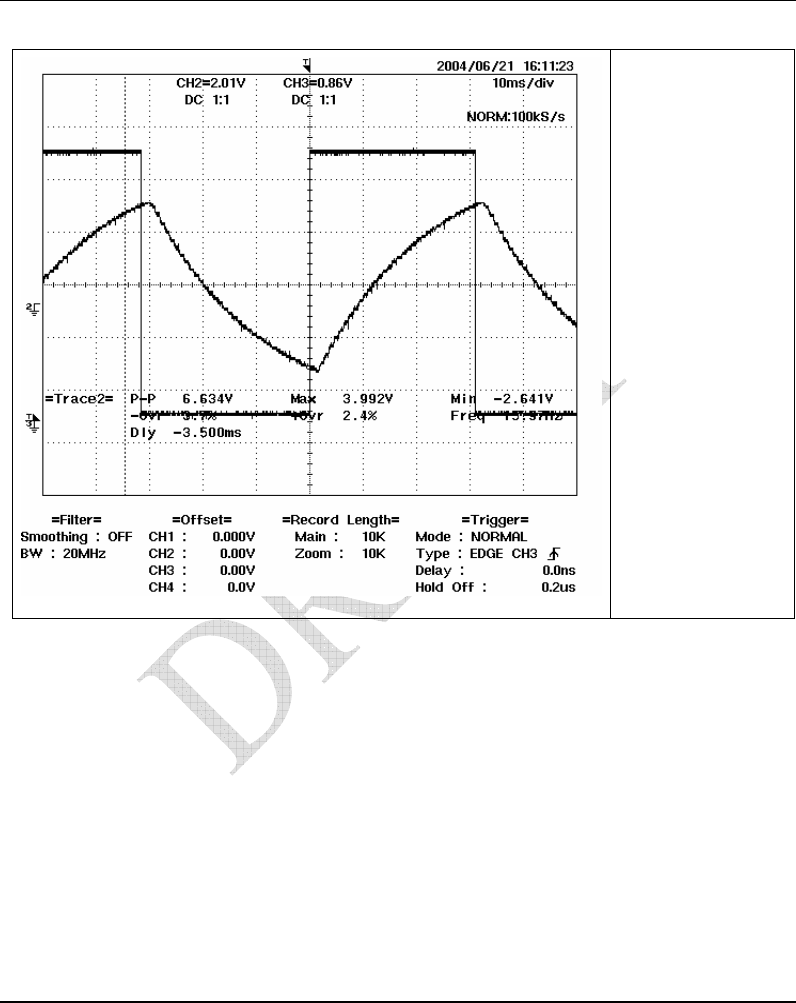
6. Appendices
6.2. APPENDIX B
Rev: A
008-0738-00
V 1.0 TMS 9250 Product User Manual 39
May 2011 Honeywell Confidential & Proprietary
INPUT : Square
Wave, 16 Hz OUPUT
: Analog Voltage
FiltLevel=10000
FiltSteps=38
Settling time to 63%
is given by
0.001 * 38 = 0.038
seconds
Therefore
overdamped
response
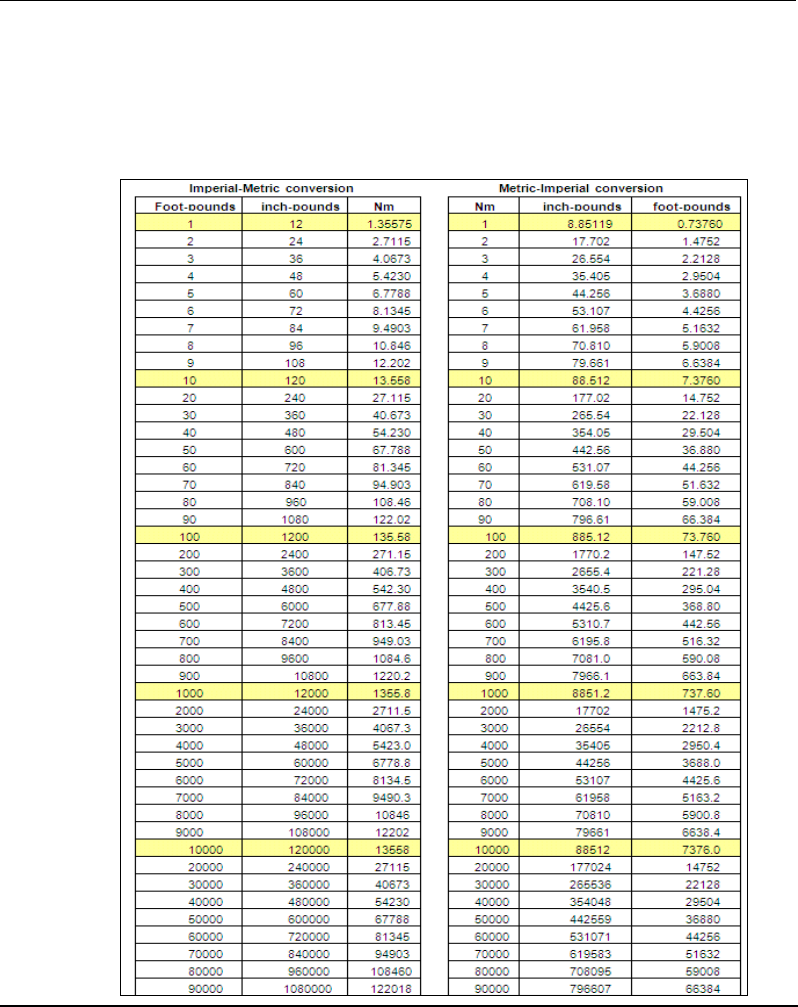
6. Appendices
6.3. APPENDIX C
Rev: A
008-0738-00
40 TMS 9250 Product User Manual V 1.0
Honeywell Confidential & Proprietary May 2011
6.3 APPENDIX C
Conversion Table

6. Appendices
6.4. APPENDIX D
Rev: A
008-0738-00
V 1.0 TMS 9250 Product User Manual 41
May 2011 Honeywell Confidential & Proprietary
6.4 APPENDIX D
This supplement provides information on positioning the power supply and cleaning instructions.
Step Action
Positioning
the power
supply
Place the power supply of the system in a place where you can
easily unplug the power cords.
Cleaning the system
Step Action
a Disconnect the power supply from the system.
b Clean the SPM, Shroud, CCM and Rotor with dry cloth.
ATTENTION
Do not use any chemicals to clean the system.
Product
Grounding
•
Shield of all the output signal shall be connected to SPM side (refer
to step 4.c of Appendix-E)
and let floating on data acquisition side
•
Third pin of power supply adapter must and shall be connected to
earth.
•
CCM shall be left floating.
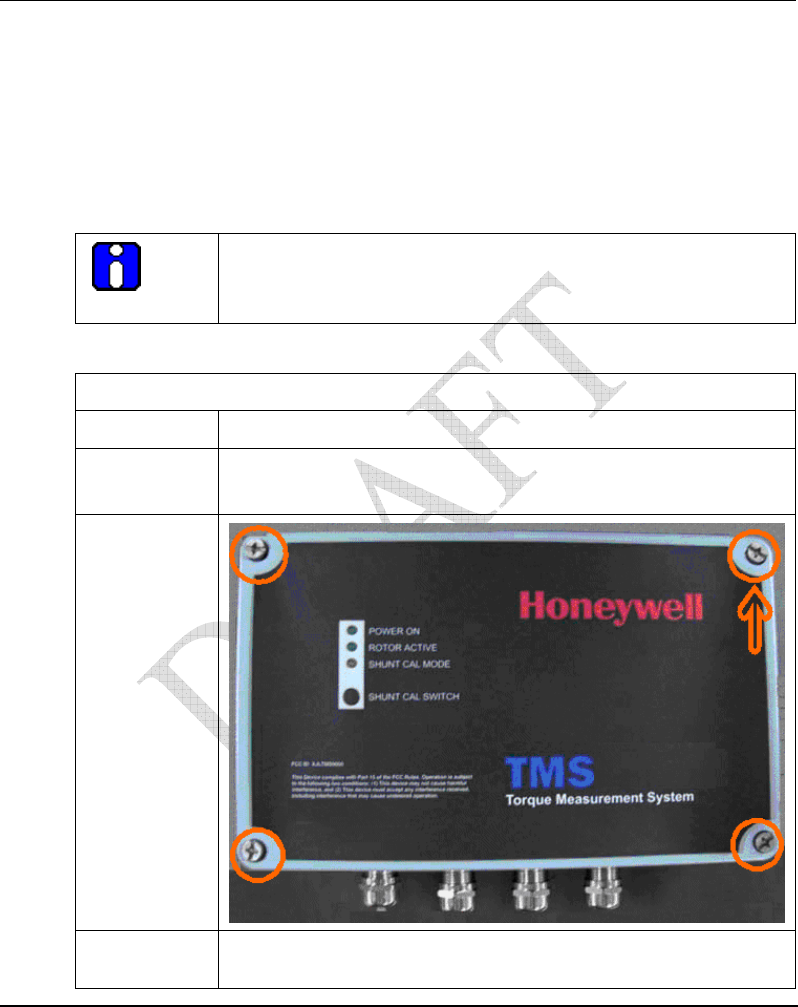
6. Appendices
6.5. APPENDIX E
Rev: A
008-0738-00
42 TMS 9250 Product User Manual V 1.0
Honeywell Confidential & Proprietary May 2011
6.5 APPENDIX E
Setting up the Cables for the Signal Processing Module (SPM)
Setting up the cables involves the following steps.
ATTENTION
The interface cables must be shielded type and connected to product
end only.
Step 1: Removing the Cover of the SPM Box
Step Action
a Keep the SPM on table with ESD plane, and wear the ESD strap.
Open the cover of the SPM box by removing the screws.
b After removing the cover, you can see the base unit of the SPM in
the following figure.
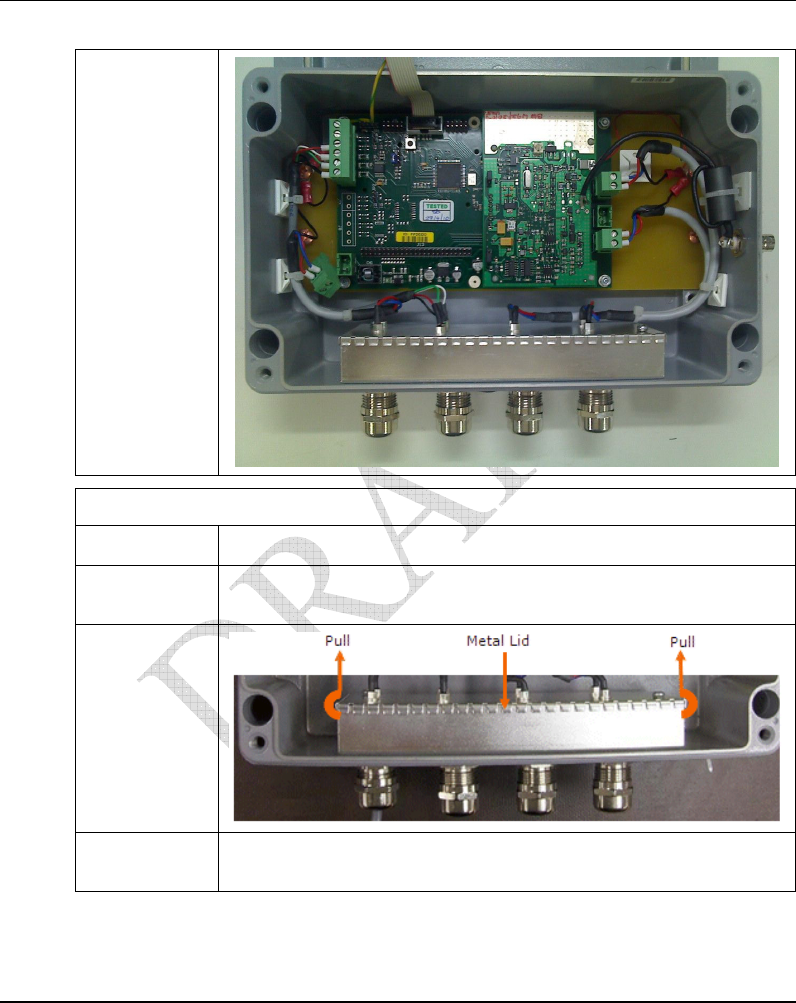
6. Appendices
6.5. APPENDIX E
Rev: A
008-0738-00
V 1.0 TMS 9250 Product User Manual 43
May 2011 Honeywell Confidential & Proprietary
Step 2: Removing the Metal Lid in the SPM Box
Step
Action
a Hold the metal lid at the end and then remove as shown in the
following figure.
b After removing the metal lid, you can see the printed circuit board as
shown in the following figure.
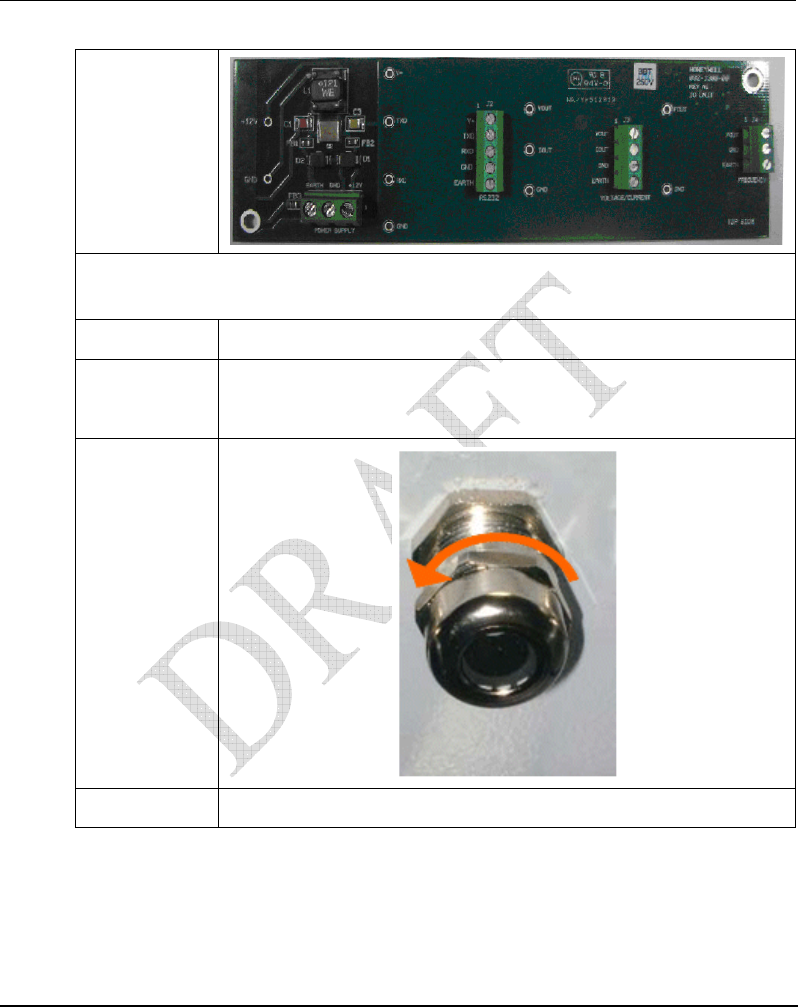
6. Appendices
6.5. APPENDIX E
Rev: A
008-0738-00
44 TMS 9250 Product User Manual V 1.0
Honeywell Confidential & Proprietary May 2011
Step 3: Removing the Glands
You must remove the glands before connecting the wires to the printed circuit board.
Step
Action
a Turn the screws of the metal glands in the counter clockwise
direction using the pliers and remove it as shown in the following
figure
b Remove the plastic cover as show in the following figure.
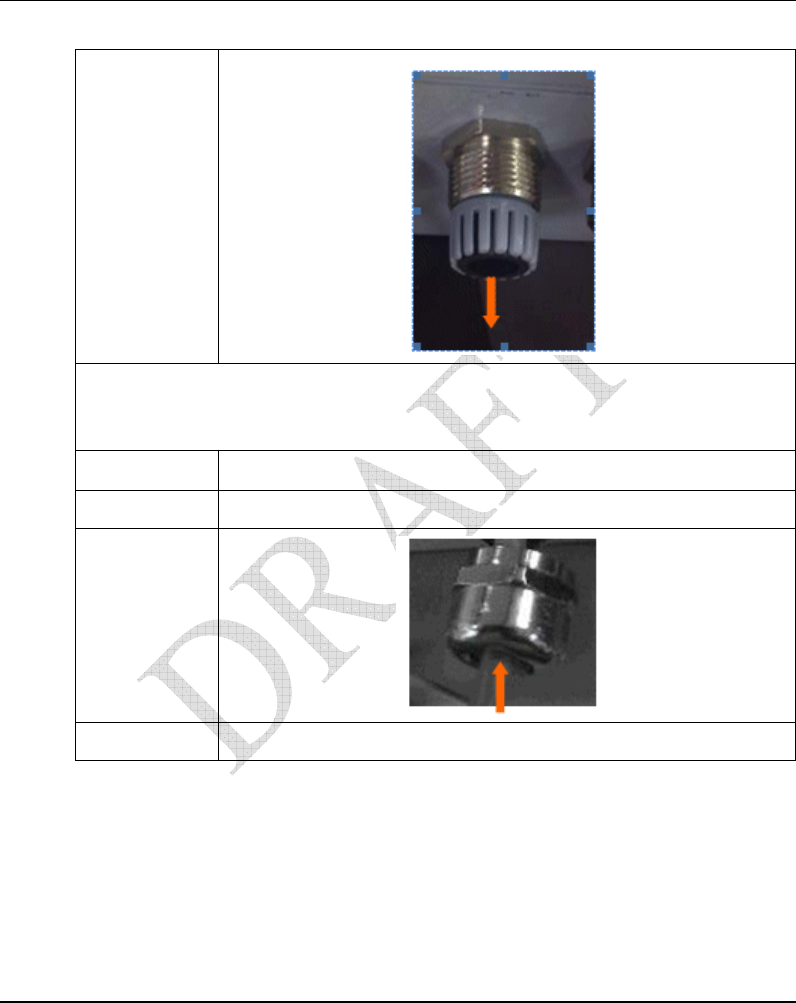
6. Appendices
6.5. APPENDIX E
Rev: A
008-0738-00
V 1.0 TMS 9250 Product User Manual 45
May 2011 Honeywell Confidential & Proprietary
Step 4: Inserting the Cables
You must insert the cables into connectors such as Analog Voltage/ Current, and
Frequency.
Step
Action
a Insert the cable into the metal gland as show in the following figure.
b Insert the cable into the plastic cover as show in the following figure.
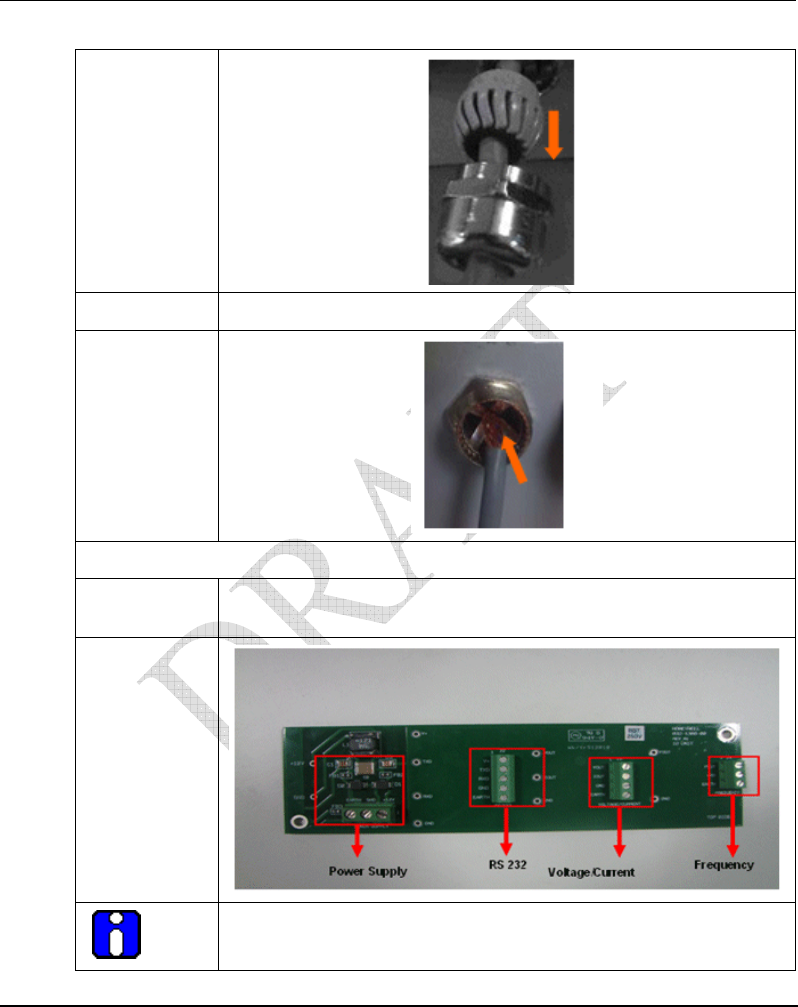
6. Appendices
6.5. APPENDIX E
Rev: A
008-0738-00
46 TMS 9250 Product User Manual V 1.0
Honeywell Confidential & Proprietary May 2011
c Connect the wire to the metal gland as show in the following figure.
Step 5: Connecting the wires to the Printed Circuit Board (PCB)
After inserting the cables into glands, you must connect the wires to
the respective connectors, inside the printed circuit board as shown.
ATTENTION
RS 232 is the only cable supplied with the product.
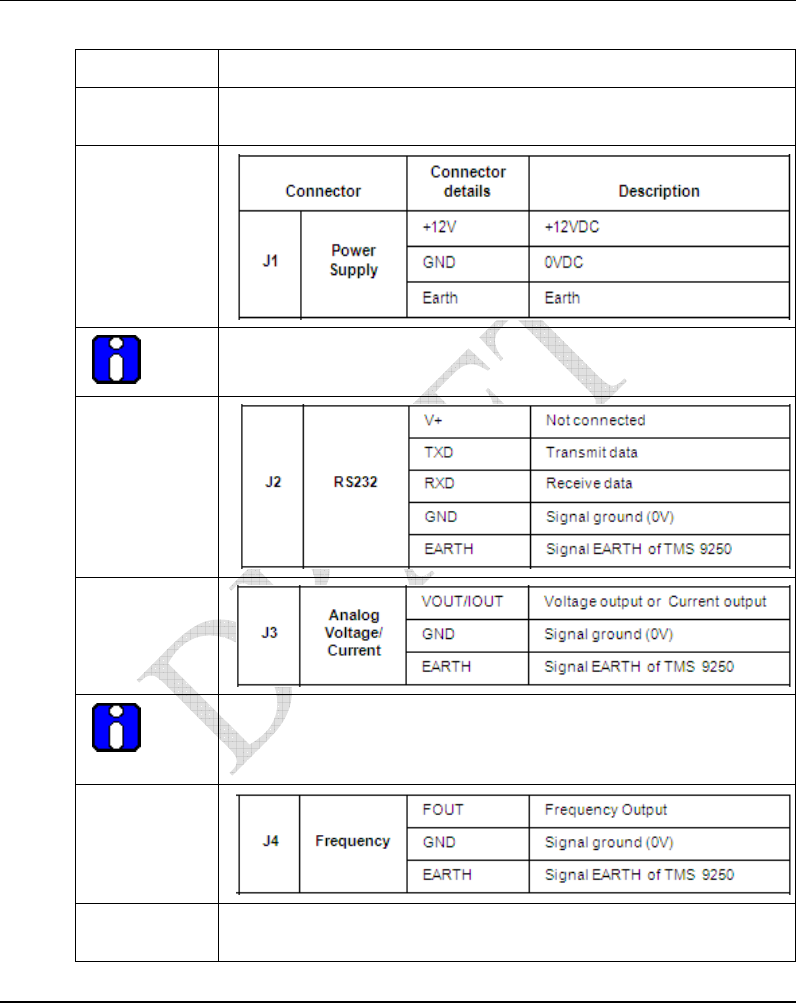
6. Appendices
6.5. APPENDIX E
Rev: A
008-0738-00
V 1.0 TMS 9250 Product User Manual 47
May 2011 Honeywell Confidential & Proprietary
Step
Action
a Loosen the screws of the connectors on the PCB and connect the
respective wires to the connectors by referring to the below table.
ATTENTION
By default, the power supply cable is connected.
ATTENTION
The output depends on OPTYPE value configured using TMS tool
kit for TMS 9250.
b After connecting the wires to respective connectors, tighten the
screws.
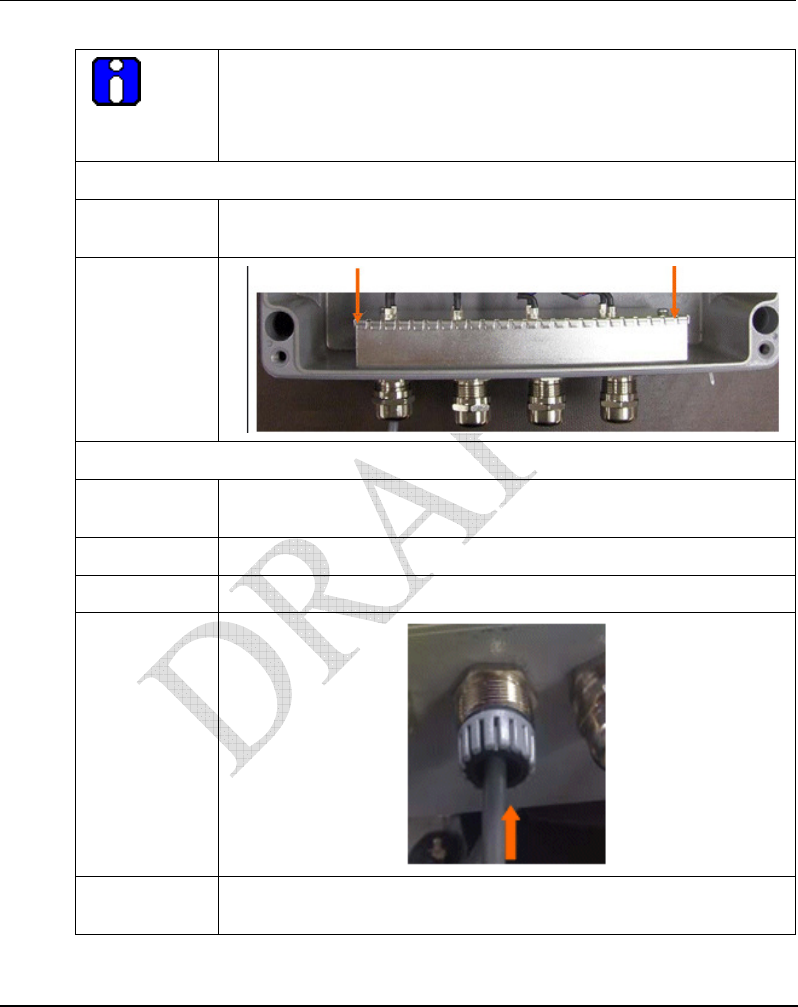
6. Appendices
6.5. APPENDIX E
Rev: A
008-0738-00
48 TMS 9250 Product User Manual V 1.0
Honeywell Confidential & Proprietary May 2011
ATTENTION
The output depends on OPTYPE value configured using TMS tool
kit for TMS 9250. Refer to the TMS Toolkit User Manual for more
information
.
Step 6: Closing the Metal Lid inside the SPM Box
a Hold the metal lid at the end and push the LID then close it as
shown in the figure.
Step 7: Closing the Glands
After closing the metal lid inside the SPM box, you must tighten the
glands.
Step
Action
a Put the plastic cover as show in the figure.
b Put the metal gland and tighten in the clock wise as show in the
figure.
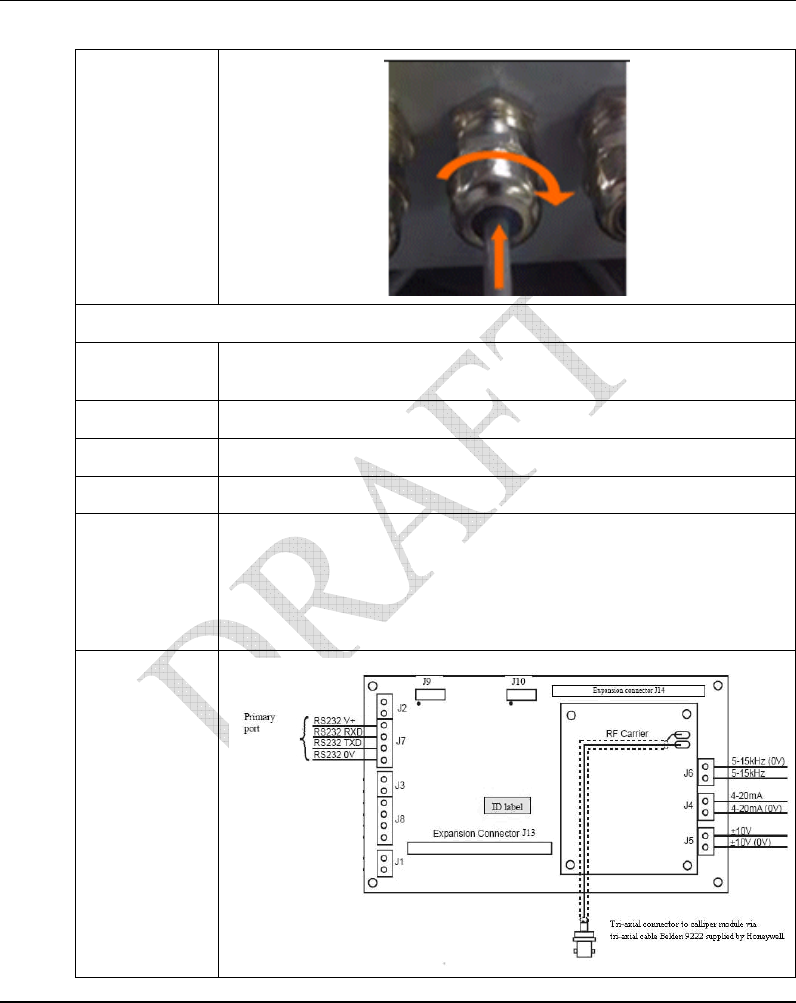
6. Appendices
6.5. APPENDIX E
Rev: A
008-0738-00
V 1.0 TMS 9250 Product User Manual 49
May 2011 Honeywell Confidential & Proprietary
Step 8: Closing the Metal Cover of the SPM Box
After closing the glands, you must close the metal cover of the SPM
box.
Step
Action
a Replace the cover on the base of the SPM box.
b Insert the screws into the screw holes and tighten it.
Electrical
Connections
The signal-processing module features two-part plug and socket
connectors and the connection details are shown in figure 2. All
cable connections should pass through the cable glands, and shield
to be connected to metal glands,as described in the Appendix-E.
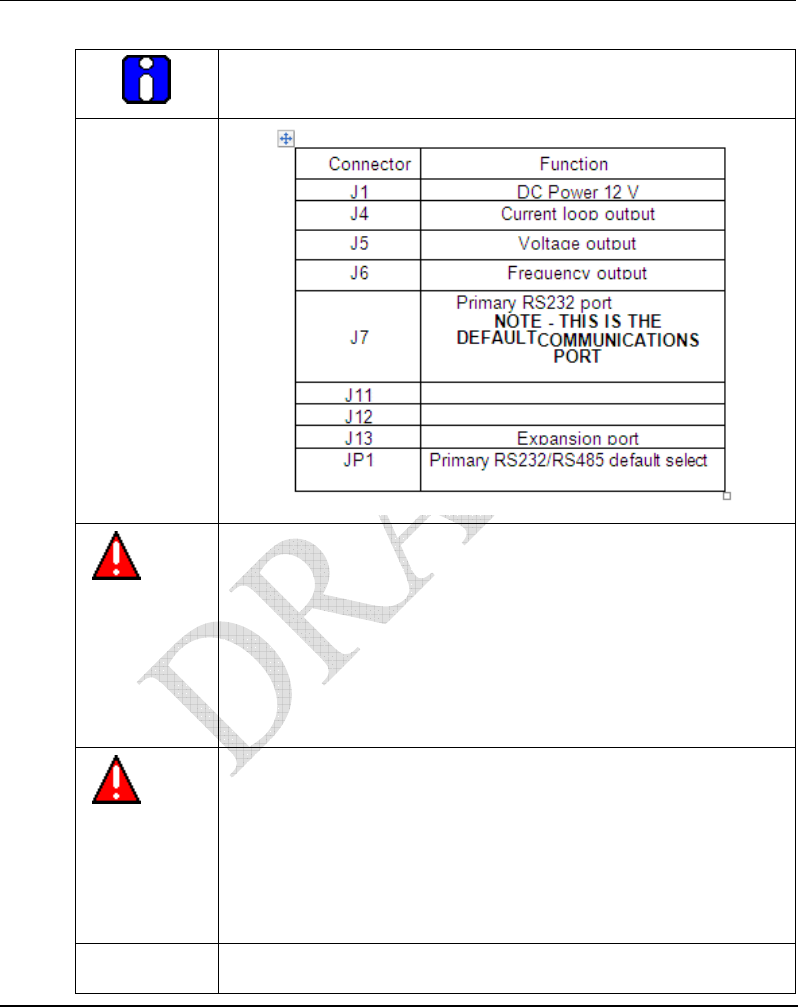
6. Appendices
6.5. APPENDIX E
Rev: A
008-0738-00
50 TMS 9250 Product User Manual V 1.0
Honeywell Confidential & Proprietary May 2011
Note
Make sure J4/J5 are not swapped with J6
Connector
and Jumper
Functions
WARNING
MISUSE OF D
O
C
U
MEN
T
ATI
O
N
•
The information presented in this product sheet is for reference
only. Do not use this document as product installation guide.
•
Complete installation, operation, and maintenance information is
provided in the instructions supplied with each product.
Failure to c
o
mply with t
h
ese instru
ct
ions could result in
death or serious injury.
WARNING
PERSONAL INJURY
DO NOT USE these products as safety or emergency stop devices
or in any other application where failure of the product could result in
personal injury.
Failure to c
o
mply with t
h
ese instru
ct
ions could result in
death or serious injury.
WARRANTY/ Honeywell warrants goods of its manufacture as being free of
defective materials and faulty workmanship. Honeywell’s standard

6. Appendices
6.5. APPENDIX E
Rev: A
008-0738-00
V 1.0 TMS 9250 Product User Manual 51
May 2011 Honeywell Confidential & Proprietary
REMEDY
product warranty applies unless agreed to otherwise by Honeywell in
writing; please refer to your order acknowledgement or consult your
local sales office for specific warranty details. If warranted goods are
returned to Honeywell during the period of coverage, Honeywell will
repair or replace, at its option, without charge those items it finds
defective.
The foregoing is buyer’s sole
r
e
medy and is in
lieu of
a
ll other
w
arr
an
ties, exp
r
es
s
ed or implied,
including tho
s
e of me
r
cha
n
tability
and fit
n
ess for a
particu
l
ar purpo
s
e. In
no eve
n
t sh
a
ll Honeywell be liable
for conseque
n
tial, special, or indirect damages.
While we provide application assistance personally, through our
literature and the Honeywell web site, it is up to the customer to
determine the suitability of the product in the application.
Specifications may change without notice. The information we
supply is believed to be accurate and reliable as of this printing.
However, we assume no responsibility for its use.
SALES AND
SERVICE
Honeywell serves its customers through a worldwide network of
sales offices, representatives and distributors. For application
assistance, current specifications, pricing or name of the nearest
Authorized Distributor, contact your local sales office or:
E-mail:
sales@sensotec.com
Internet:
www.honeywell.com/sensotec
Phone and
F
ax:
Tel: 614-850-5000
Fax: 614-850-1111

V 1.0 TMS 9250 Product User Manual 53
May 2011 Honeywell Confidential & Proprietary
